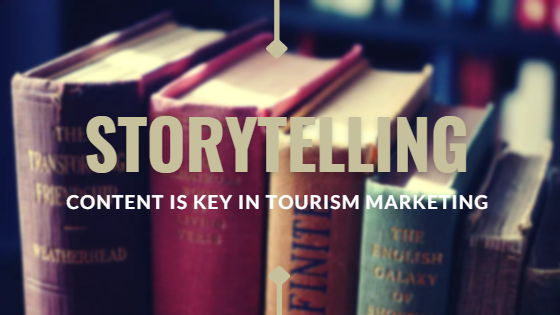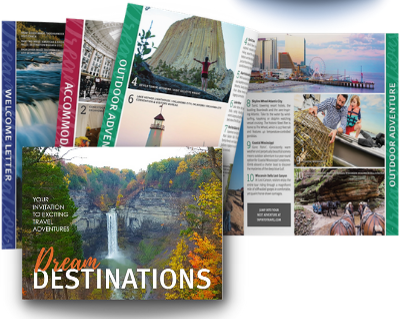Storytelling Content is Key in Tourism Marketing
Visitors guides are moving more and more into the digital realm. Especially following 2020, many DMOs have moved to digital-only or a mix of printed guides and digital offerings. Even so, the demand remains high for the information offered, as visitors try to work out what they want. What attractions to see, where to grab a bite, and the best assets offered in a particular destination. The way visitors process and absorb information is evolving and changing along with the medium. Guides are competing with other online content. And they need to work in different ways for visitors to plan. Travelers demand more creative content and in-depth storytelling – moving beyond just listings to tell deeper, more compelling stories.

A Storytelling Guide
I’ve seen other travel guides following this trend. We experienced the shift first in 2018, as our team worked on a new guide for the Haunted History Trail of New York State. In its fifth year as an official tourism trail, the Haunted History Trail faced challenges as visitors tried to figure out how to follow the trail. Do they hit every stop in order? Follow a region? Pick a single stop or two? Hours and location offerings changed based on seasonality- another challenge to contend with. Past guides were trying to be everything to everyone. While they managed to offer relevant information, we were simultaneously falling short on telling the story.
And that was the key right there – storytelling. This trail was a series of listings, a collection of stops – but the guide didn’t support the story that New York is a full-on haunted destination. When a visitor travels to Hawaii, they are immersed in a culture of pineapples, Mai Tais, leis, and an alphabet consisting of mostly vowels. Storytelling would allow us to build a picture in the visitor’s mind and better immerse visitors in the stories of the trail.
As visitors become inundated with content, they don’t want to be sold to. They are looking to instead learn, discover, and immerse themselves in a new narrative. Visitors guides are a destination’s opportunity to write their story, their way. To seek out the most compelling new angles that make consumers want to visit and to give people the inside scoop. To be able to tell the stories you wish the media was writing.
When to Use Listings
Not every guide calls for an in-depth approach, so don’t ditch the listing style completely. There is still a time and a place for that type of content – and space for that in the market.
Listings are a great tool for a mini guide or niche offering. Take the Finger Lakes “50 Top Attractions” Guide. A roundup of the 9,000 square mile destination could easily take up 40 or 50 pages of space – far too much content for a visitor to dive into. But with a narrowed focus and a catchy title, this type of guide hits all of the highlights for a visitor already planning a trip to the region.
Consider Content Versus Need
In the end, content needs to be about the visitor. We moved away from a listing style for the Haunted History Trail guide, but were careful not to lose the factual information that made the guide a true resource. While working with a travel magazine style, we still geo-plotted each location on an inside cover map, and listed every location with their contact info in a rear index.
In 2019, we revamped a brochure produced by our client Travel Alliance Partners (TAP). TAP’s North American tour operators specialize in specific areas of geographical expertise and work together to develop tour packages with the highest quality, best value and biggest variety. Destinations that are members of TAP’s Guild program are featured in the “Dream Destinations” magazine.
Previous versions had categories organized by geography alone, and ranged from full destinations to individual attractions and hotels. The paid investment level drew focus for content instead of the consumer experience, negatively affecting the flow of the magazine and likely confusing the reader. Members submitted content individually without voice or style guides, which resulted in inconsistent messaging.
Focusing on Experience
For the 2019 TAP Dream Destinations magazine, we threw out the template and considered the consumer as the primary driver for this guide. We looked at each destination critically and we would turn to storytelling by focusing on the experiences. We created experience-driven categories – craft beverage, outdoor adventure, food, scenery, sports, etc. Each member selected their top 3 categories core to their destination for inclusion. Our team created a layout easily understood and enticing to potential visitors. The table of contents shared how visitors can browse by topic or location. Listing page numbers help them quickly find the content that best fit their interests.
In collaboration with our designer, we worked out a design that would be visually impactful and easily digestible for readers. Photos appeared at the forefront of each section and we organized the copy into a Top 5 listing (or more in popular categories) with a short intro per section. Section titles run vertically up the page for quick reference. Articles ended with a one sentence call-to-action, encouraging readers to visit the website to learn more or book a tour. We reviewed and edited every piece extensively to ensure similar voice, style and tone. A two-page spread at the end shared a logo and website for each member featured within the guide.
The End
The end game is to drive visitors to your destination, yes. But the key is to first compel them to learn your story, explore deeper, and provide a resource that can be used through the entire travel experience. Consider your content and your story, and your next guide will do just that.
Author
Related Posts
Collaboration Drives Sustainable Tourism
Sustainable tourism has growing importance in the world of travel and tourism. As destinations grow in popularity, they need to collaborate closely with residents, local…
How to Use AI For Tourism Marketing
Artificial Intelligence is a top trend in every space right now. It is transcending digital and becoming part of the conversation for just about everything…

